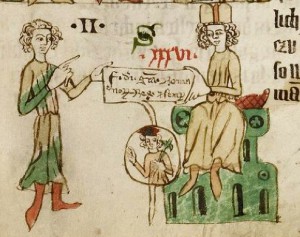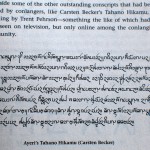Ayeri makes use of grammatical gender to at least some degree. As a category, gender is by far not as pervasive as in Romance languages, though, since in Ayeri it only matters in picking the correct case suffix for agents and patients (animate vs. inanimate) as well as in 3rd person pronouns and verb agreement (masculine/feminine/neuter animate vs. inanimate). The fact that gender plays a role in verb agreement opens up possibilities for adding some quirks. As pointed out in a previous blog article,
Ayeri usually exhibits verbs as agreeing with agents and occasionally patients, not topics as such. This may be a little counterintuitive since the relation between topics and subjects is close, but is possibly due to the fact that the unmarked word order is VAP. This means that agent NPs usually follow the verb, and it strikes me as not too unnatural to have an agreement relation between the verb and the closest NP also when non-conjoined NPs are involved (Corbett [2006:] 180). This conveniently explains why verbs can agree with patients as well if the agent NP is absent.
This brings up the idea that Ayeri should likely exhibit agreement with the closest conjunct when a word is forced to agree with coordinated NPs of different genders, instead of finding some way to resolve conflicting gender features. Yet, however, I have often been following the rule that a masculine entity and a feminine entity, regardless of number, resolve to masculine as the default gender, though sometimes I have also used the neuter as a third category to escape to (Wechsler 2009 actually quotes Icelandic as following this route):
| M | + | F | = | M | (N attested) |
| F | + | M | = | M | (N attested) |
I was originally wondering if I should get rid of this system and instead use nearest-conjunct agreement throughout, but—why not have both? In this little blog article I basically want to sketch out an idea I had in the hope that it is well within the confines of what natural languages do. Note that the tables given in the following refer strictly to verb agreement, where the verb precedes any NPs it agrees with. Thus, for the outcome of nearest-conjunct agreement, it is assumed that the agreement target precedes the agreement controller, so that the verb should in most cases agree with the first conjunct.
Now, if NPs referring to people or other entities to which masculine and feminine apply as grammatical categories have their diverging gender features resolved to masculine as the default, what about combining either masculine or feminine with neuter? This is shown in the following table:
| M | + | N | = | M | |
| N | + | M | = | N | |
| F | + | N | = | M | (F possible) |
| N | + | F | = | N |
From this table we can gather that in general, there is nearest-conjunct agreement for combinations of masculine/feminine and neuter, though feminine and neuter equally resolve to masculine as the default if the feminine conjunct is closer to the agreement target. Note that for agreement with simplex NPs, there is no default gender, so masculine gender will trigger masculine agreement, feminine gender will trigger feminine agreement, etc. As indicated in the table above, true nearest-conjunct agreement with the feminine conjunct is possible as well, however, basically ignoring any further complications. It takes not a lot of imagination to assume that the regularization towards nearest-conjunct agreement would be a point of divergence between the formal and the colloquial language and also very likely a fertile ground for prescriptivist bickering.
So far, we have only looked at the combinations within the animate tier. The following table lists the possible permutations for combinations of animate and inanimate NPs:
| M | + | INAN | = | M | |
| INAN | + | M | = | INAN | |
| F | + | INAN | = | M | (F possible) |
| INAN | + | F | = | INAN | |
| N | + | INAN | = | N | |
| INAN | + | N | = | INAN |
For consistency, the same rules as above operate here: masculine and feminine mixed with inanimate show nearest-conjunct agreement. If, however, a feminine conjunct comes first, agreement will default to masculine, though again, nearest-conjunct agreement to feminine is possible.
Wechsler (2009: 571–73) furthermore discusses Corbett (1991)’s observation that there may be differences in how languages go about gender resolution with regards to semantic and syntactic resolution—i.e. resolution of conflicts in gender between the semantics and the form of a word—and finds that animacy plays a role in that. This is relevant in cases where grammatical and semantic gender diverge, as in hybrid nouns like German Mädchen ‘girl’. Mädchen semantically refers to a female person but by its form is of neuter gender, since the diminutive suffix -chen always derives neuter nouns. The question now is, which gender do pronouns and agreement referring to the girl have, neuter or feminine? In fact, variation can be observed in these cases.
While Ayeri assigns masculine and feminine semantically (with neuter for the remainder of animate entities which are neither male nor female), there are occasional idiosyncrasies with nouns very obviously referring to non-living things being assigned animate neuter gender, such as nanga ‘house’. It might be interesting to develop some further ideas for likely outcomes in that regard even though canonically, nearest-conjunct agreement should operate in those cases and conlangs, by their nature, probably produce a lot less variation than actual natural languages do.
- Corbett, Greville G. Agreement. Cambridge: Cambridge UP, 2006. Print. Cambridge Textbooks in Linguistics.
- ———. Gender. Cambridge: Cambridge UP, 1991. Print. Cambridge Textbooks in Linguistics.
- Wechsler, Steven. “‘Elsewhere’ in Gender Resolution.” The Nature of the Word: Studies in Honor of Paul Kiparsky. Ed. by Kristin Hanson and Sharon Inkelas. Cambridge, MA: MIT Press, 2009. Print. 567–586. Current Studies in Linguistics.
- I can’t seem to keep my terminology straight: I corrected *nearest-conjunct resolution to nearest-conjunct agreement in a few places.







